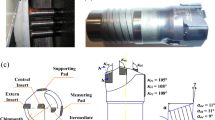Abstract
Drilling is used in a very large variety of applications, which is one of the most complex manufacturing processes and is a semi-enclosed cutting process. The use of titanium alloy Ti6Al4V in engineering applications has increased in recent years, and in many of these applications drilling is one of the most critical stages in the manufacturing process. Critical issues in drilling of Ti6Al4V are often associated with large drilling forces and short life. Understanding and predicting the drilling forces occurring during drilling of Ti6Al4V would allow extending the currently used optimization methods and proposing new tool geometries and tool materials. The current paper introduces an improved mechanistic model for predicting the drilling force distribution along the main cutting edge and chisel edge of a drill, which considered the effect of feed rate. Based on the definitions of working angles, the equivalent model of drilling is developed. The effect of feed rate on the working rake angle was also investigated. Then, the drilling force model in the main cutting edge is developed based on the oblique cutting model. However, there are two different equivalent regions in chisel edge; here the drilling force model is developed based on orthogonal cutting model and plastic extrusion model, respectively. A special drilling forces distribution experiments are carried out in drilling Ti6Al4V. Good agreement between the measured and predicted drilling forces is found.












Similar content being viewed by others
References
Brinksmeier E (1990) Prediction of Tool Fracture in Drilling. Ann CIRP 39(1):97–100
Kim SW, Lee DW, Kang MC, Kim JS (2001) Evaluation of machinability by cutting environments in high-speed milling of difficult-to-cut materials. J Mater Process Technol 111:256–260
Lazar Mihai-Bogdan, Xirouchakis Paul (2013) Mechanical load distribution along the main cutting edges in drilling. J Mater Process Technol 213:245–260
Oxford CJ (1955) On the drilling of metals-I: basic mechanics of the process. Trans ASME 77:103–104
Shaw MC, Oxford CJ (1957) On the drilling of metals-II: the torque and thrust in drilling. Trans ASME 79:139–148
Bera SK, Bhattacharyya A (1968) On the determination of torque and thrust during drilling of ductile materials. Pro Eighth Mach Tool Des Res Conf:879–892
Williams RA (1970) A study of the basic mechanics of the chisel edge of a twist drill. Int J Prod 8(4):325–343
Williams RA (1974) A study of the drilling process. J Eng Ind Trans ASME 96:1207–1215
Armarego EJA, Cheng CY (1972) Drilling with flat rake face and conventional twist drills. I: theoretical investigation. Int J Mach Tool Des Res 12:17–35
Armarego EJA, Cheng CY (1972) Drilling with flat rake face and conventional twist drills.II: experimental Investigation. Int J Mach Tool Des Res 12:37–54
Armarego EJA, Wiriyacosol S (1979) Thrust and torque prediction in drilling from a cutting mechanics approaches. Ann CIRP 28:87–91
Armarego EJA, Wright JD (1984) Predictive models for drilling thrust and torque-A comparion of three flank configurations. Ann CIRP 33(1):5–10
Watson AR (1985) Drilling model for cutting lip and chisel edge and comparison of experimental and predicted results I: initial cutting lip model. Int J Mach Tool Des Res 25(4):347–365
Watson AR (1985) Drilling model for cutting lip and chisel edge and comparison of experimental and predicted results III: drilling model for chisel edge. Int J Mach Tool Des Res 25(4):377–392
Watson AR (1985) Drilling model for cutting lip and chisel edge and comparison of experimental and predicted results IV: drilling tests to determine chisel edge contribution to torque and thrust. Int J Mach Tool Des Res 25(4):393–404
Stephenson DA (1989) Material characterization for metal-cutting force modeling. ASME J Eng Ind 111:210–218
Stephenson DA, Agapiou JS (1992) Calculation of main cutting edge forces and torque for drills with arbitrary point geometries. Int J Mach Tools Manuf 32(4):521–538
Bera SK, Bhattacharyya A (1996) Mechanics of drilling process. J Inst Eng (India) 46(11):265–276
Wang JL (1994) Development of new drilling force models for improving drill point geometries, Ph.D. Thesis, University of Michigan
Chen Y (1999) Drilling process modeling for new drilling process development. Ph.D. Thesis, University of Michigan
Elhachimi M, Torbaty S, Joyot P (1999) Mechanical modeling of high speed drilling. 1: predicting torque and thrust. Int J Mach Tools Manuf 39(4):553–568
Elhachimi M, Torbaty S, Joyot P (1999) Mechanical modeling of high speed drilling. 2: predicted and experimental results. Int J Mach Tools Manuf 39(4):569–581
Chandrasekharan V (1996) A model to predict the three-dimensional cutting force system for drilling with arbitrary point geometry, Ph.D. Thesis, University of Illinois
Wang J, Zhang Q (2008) A study of high-performance plane rake faced twist drills. Part II: predictive force models. Int J Mach Tools Manuf 48:1286–1295
Sahu Sushanta K, DeVor Richard E, Kapoor SG (2004) Modeling of forces for drills with chip-breaking grooves. J Manuf Sci Eng 126:555–564
Gong Yongping, Lin Cheng, Ehmann Kornel F (2005) Dynamics of Initial Penetration in Drilling: part 1: mechanistic model for dynamic forces. Trans ASME 127:280–288
Jian Wu, Han Rongdi (2009) A new approach to predicting the maximum temperature in dry drilling based on a finite element model. J Manuf Process 11:19–30
Jian Wu, Han Rongdi (2013) Research on experiments with water vapor as coolant and lubricant in drilling Ti6Al4V. Ind Lubr Tribol 65:50–60
Acknowledgments
This work is supported by the Scientific Research Foundation of Harbin Institute of Technology at Weihai [HIT(WH)X201104] and National Science Foundation of China (50675053).
Author information
Authors and Affiliations
Corresponding author
Additional information
Technical Editor: Alexandre Mendes Abrao.
Rights and permissions
About this article
Cite this article
Wu, J., Wen, J. & Wang, Z. Study on the predicted model and experiment of drilling forces in drilling Ti6Al4V. J Braz. Soc. Mech. Sci. Eng. 38, 465–472 (2016). https://doi.org/10.1007/s40430-014-0304-2
Received:
Accepted:
Published:
Issue Date:
DOI: https://doi.org/10.1007/s40430-014-0304-2




